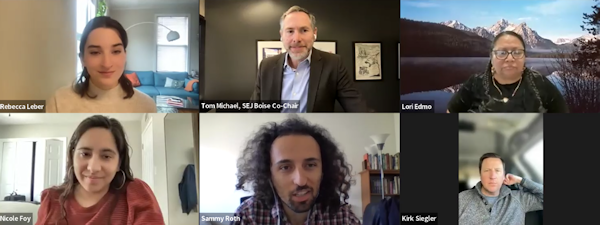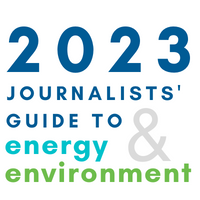SEJournal Online is the digital news magazine of the Society of Environmental Journalists. Learn more about SEJournal Online, including submission, subscription and advertising information.
 |
| Speakers at the 2023 Guide panel on Feb. 9, 2023. Image: SEJ |
SEJ News: SEJ Panel Gauges Issues in the Works in the U.S. West
By Robert McClure
What’s ahead on the energy and environmental front in the West in 2023? Veteran journalists gathered last week at a Society of Environmental Journalists’ webinar to offer concrete suggestions for reporters covering the region, including:
 |
- The housing-affordability angle to the Western fires story.
- How local governments’ zoning authority is allowing increased development where people are likely to suffer ongoing fire impacts.
- Can humanity’s existential imperative to temper climate change mesh with the economic and political realities playing out in the debate on natural gas in the West — despite persistent and widespread greenwashing?
- As the climate warms, what is society’s obligation to Indigenous peoples who count on salmon that depend on cold water?
- How can the need to significantly boost renewable energy capacity be squared with the fact that projects to build remote solar and wind farms, and the associated transmission lines, are overwhelmingly resisted by the rural residents where these would go? (This includes Native American tribes.)
- What are our obligations to the farmworkers who work outdoors even amid the escalating temperatures and the smoky skies of a changing climate, while they also incur health risks of pesticides?
Impacts of infrastructure projects
Opening the panel discussion, Sammy Roth, who covers energy for the Los Angeles Times, discussed barriers to building wind and solar farms: “The biggest obstacle to building the renewable energy infrastructure that’s going to be needed to meet climate targets are these land-based conflicts about where do you put this stuff?” Roth said. “How do you get it built and sited in a way that it’s not creating problems for, say, rural farming communities or destroying wildlife habitat or interrupting sight lines that people don’t want to see interrupted?”
‘Almost everywhere I’ve seen large
renewable-energy infrastructure
proposed in the Western United States,
there’s local opposition that bubbles up.’
— Sammy Roth, L.A. Times
He added: “The reality is that almost everywhere I’ve seen large renewable-energy infrastructure proposed in the Western United States, there’s local opposition that bubbles up against that. Getting this stuff built much more quickly and at a larger scale than we’re getting it built now is going to require navigating these conflicts and ultimately threading a very fine needle.”
Lori Edmo, editor of Sho-Ban News in Fort Hall, Idaho, later described how Native Americans saw their ability to catch culturally important salmon circumscribed first by development of dams and other infrastructure, then later by state game officials to protect the declining salmon stock tribes depend upon. Then they won legal battles to ensure their ability to hunt the salmon.
While only four salmon returned one year for one notoriously imperiled stock at Idaho’s Redfish Lake, that stock and some others are being rebuilt. But often that’s with the aid of hatcheries, which scientists have shown to be genetically risky for some stocks.
Edmo described how her daughter has learned the native ways to fillet and smoke salmon caught in July for use throughout the year: “These are really important parts of our tradition and our culture. And it’s really our way of life,” she said.
Making sense of natural gas
Rebecca Leber, senior reporter at Vox, addressed the lack of regulation around so-called “natural” gas when it comes to its climate impacts, as well as “misinformation” on the issue that journalists can help cut through.
Stories abound at all levels:
- In cities, where local leaders are thinking about forbidding future installation of gas appliances;
- In states, particularly conservative states, where legislators are moving to preclude such local pro-climate measures;
- At the federal level, where regulatory officials are looking at the evolving science of how indoor gas use, to a surprising degree, affects human health. The Consumer Product Safety Commission recently announced a review.
- Between states. One study documented how gas appliances actually make a significant contribution to cross-state air pollution.
Leber said she was inspired to delve into this important indoor air quality issue when the COVID pandemic set in and she realized how much time people spend indoors. At a panel she plans for the upcoming annual SEJ conference in Boise in April, she said, “I hope to bring together perspectives from the scientific community, policy makers and the gas industry itself to make more sense of all of these conflicting sources of information.”
‘Context is everything’
Kirk Siegler, a correspondent for the national desk at National Public Radio, noted that wildfire “directly affects tens of thousands on a good year in the West, maybe hundreds of thousands in a worse year, but in terms of air quality, it will affect tens of millions of us.”
He urged reporters, even those engaged in run-and-gun coverage of fires, to dig deep and impart wisdom to viewers, listeners and readers because “context is everything.”
‘Yes, we have to do the daily update
… But more and more, context is key,
even if it’s just a short spot news event.’
— Kirk Siegler, NPR
“Yes, we have to do the daily update — the acres burned, the containment lines and that kind of thing, and the death toll and all the grim stuff. But more and more, context is key, even if it’s just a short spot news event. You know, a little bit of explanation. What’s going on? Is it the climate? Yes. Is it forest management? Yes. It’s not just one thing.”
Siegler also identified a huge factor in the modern fire scene that is severely undercovered: “We have an explosion of home development” in fire-prone areas of the West. “Whole subdivisions, whole cities (are) moving into wildfire-prone areas.”
This 2015 piece by Siegler delves into the issue. For a super-recent look at how this is playing out in Washington state, I recommend this story by Anushuya Thapa of InvestigateWest. (Full disclosure: I was an InvestigateWest co-founder, but no longer work there. Like Siegler, InvestigateWest has long sought to expose this issue.)
Siegler also raised the provocative issue of how the housing affordability crisis is affecting the number of people at risk from fires, because many seek cheaper rents in the countryside. (Social justice issues around wildfire also will be raised in a panel I am organizing for the Boise conference.)
Farmworkers on the front lines
Nicole Foy, who reports on California’s Central Valley for CalMatters, urged more coverage of how climate change increasingly is threatening the health of farmworkers who must endure increasing temperatures as well as more frequent incursions of soot-soaked air from the increasingly intense wildfires.
She recalled recent years when smoke filled the Western skies, including when she worked in Boise.
“Most of us try to stay inside next to our air purifiers, and I would go out in the fields and see farmworkers there working throughout the whole time,” Foy recalled. “Farmworkers in Idaho and of course around the country really do end up being on the front lines of the impacts of climate change.”
She also noted how some parents are concerned about levels of pesticides on food their children eat, but that children of farmworkers can be exposed to much higher levels of pesticides in their everyday environment. Foy urged journalists to talk with farmworkers.
“When it comes to measuring … the totality of environmental impacts on our communities, whether in Boise, Idaho, or in areas around the country, you have to make sure you are including all of the voices in those discussions, “she said. “Otherwise, we’re not getting a full picture of what needs to be done.”
[Editor’s Note: Watch video of the hour-long panel session. In addition, each of the panelists is organizing a session at SEJ’s annual conference in Boise, April 19-23, where these topics will be explored further. For more on issues ahead in 2023, visit our 2023 Journalists’ Guide, which includes an overview analysis and a special TipSheet on reporting from the Cascadia bioregion.]
Robert McClure is a veteran journalist specializing in in-depth coverage of climate and energy issues. He previously co-founded InvestigateWest, a nonprofit newsroom in Seattle, where he served as executive director and executive editor, and worked in newspapers for 30 years before that. A finalist for a Pulitzer Prize and winner of the John B. Oakes Award for Distinguished Environmental Journalism, McClure was named as one of Seattle Magazine’s “most influential people” in the city. He was also the recipient of professional fellowships funded by the Knight Foundation that allowed him to study at the University of Michigan, MIT and Harvard. He served on the Society of Environmental Journalists' board of directors for 12 years and continues to serve as chair of the SEJ Editorial Advisory Board.
* From the weekly news magazine SEJournal Online, Vol. 8, No. 7. Content from each new issue of SEJournal Online is available to the public via the SEJournal Online main page. Subscribe to the e-newsletter here. And see past issues of the SEJournal archived here.













 Advertisement
Advertisement 



